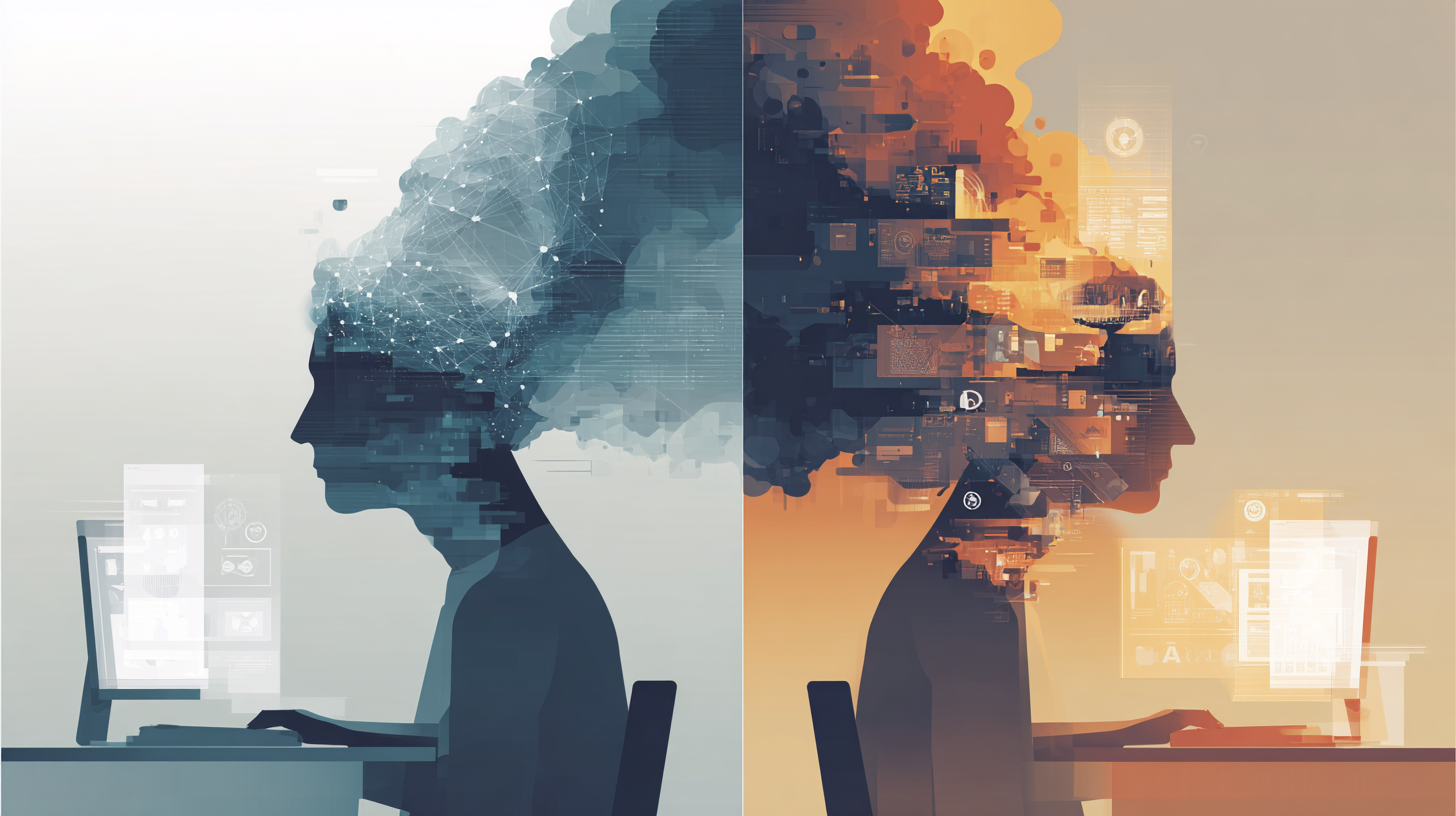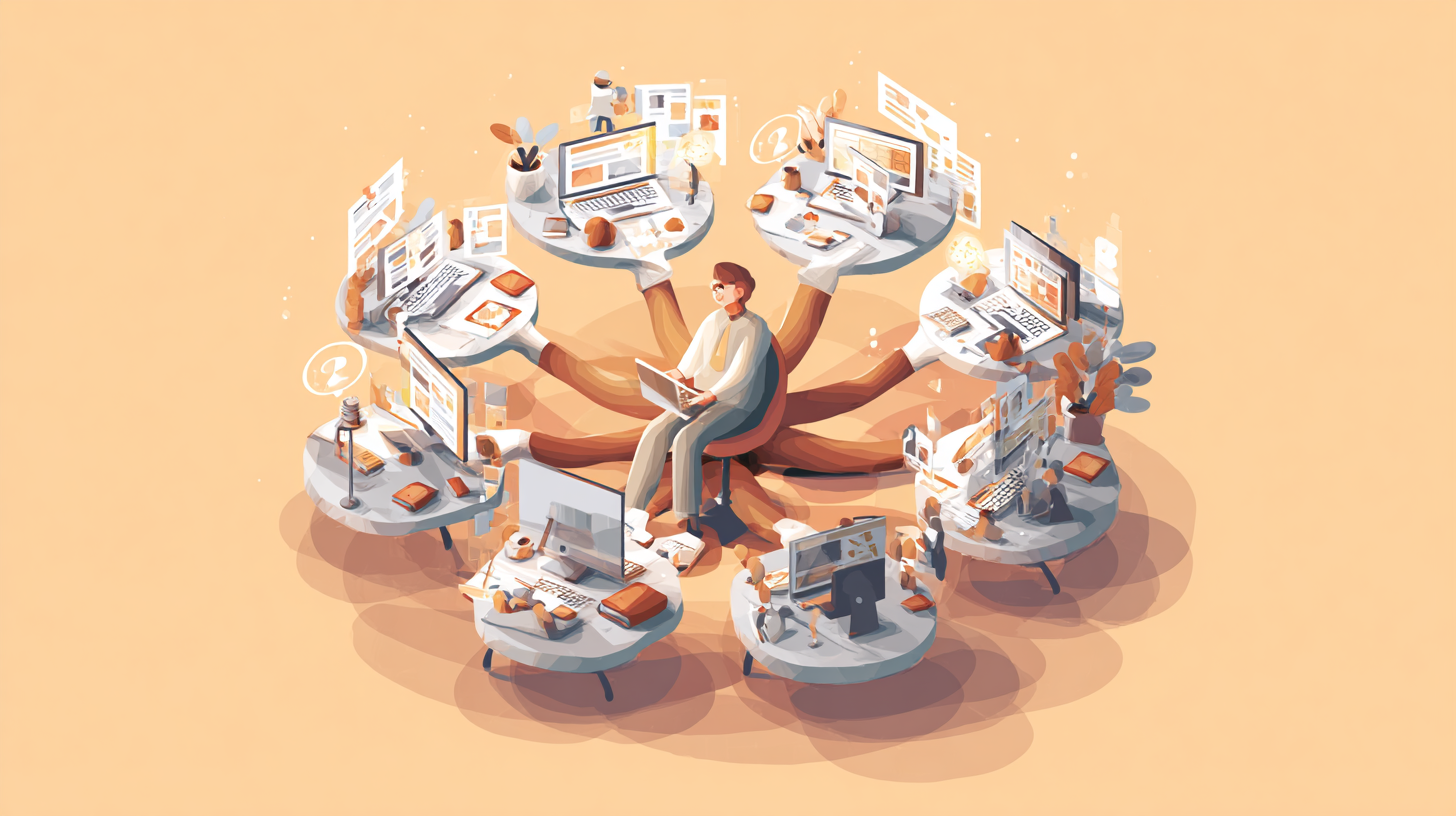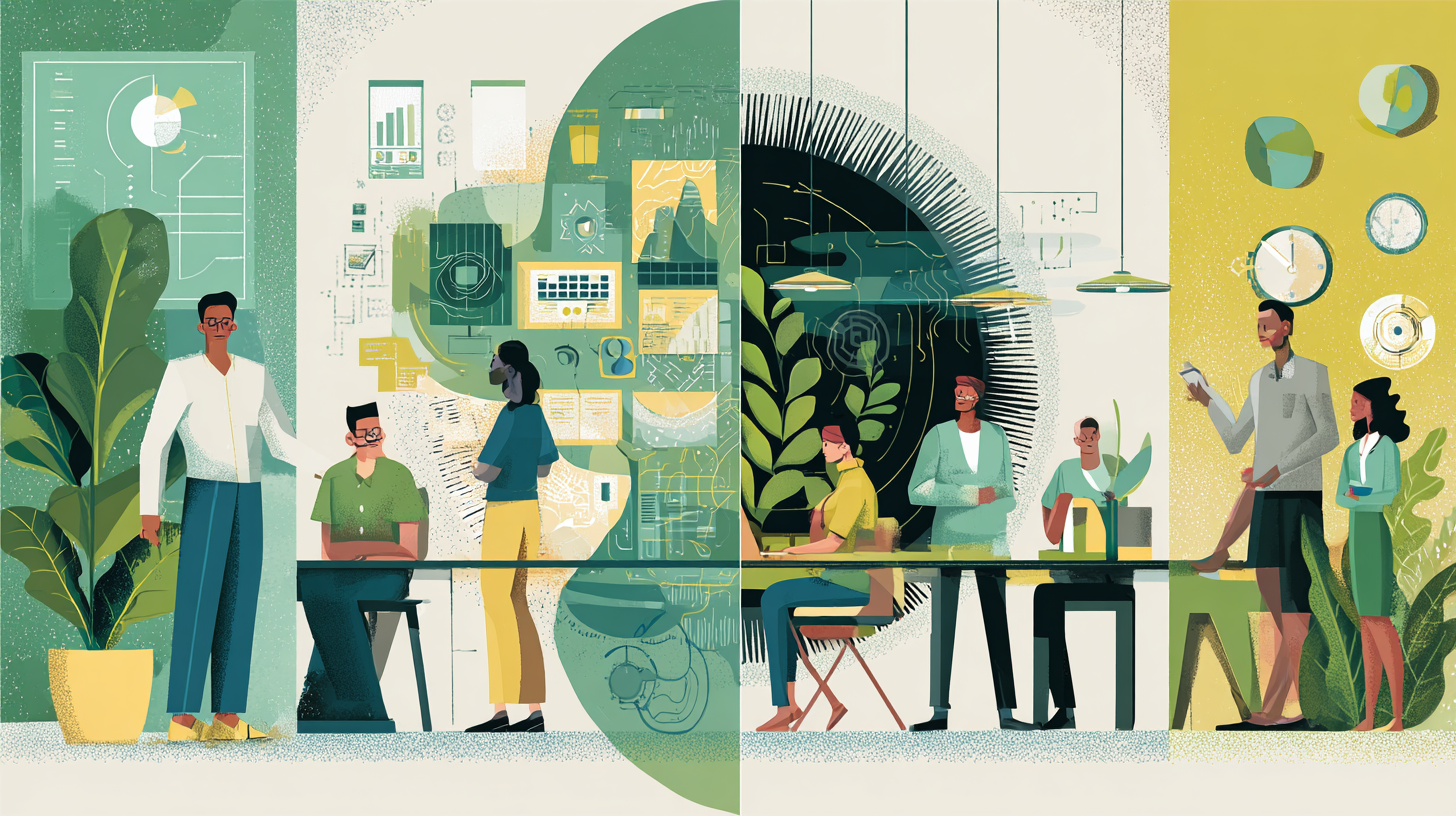The Cognitive Cost of Unlimited Productivity
An Analysis of AI Burnout and Polywork Phenomena in the Age of Artificial Intelligence

Abstract
This report examines the paradoxical relationship between AI-enhanced productivity and human wellbeing, focusing on the phenomenon of AI burnout and the rise of polywork enabled by artificial intelligence. Through analysis of cognitive load theory, technostress frameworks, and emerging workplace patterns, we demonstrate that AI's promise to reduce workload has instead created new forms of cognitive burden and psychological strain. The study provides a comprehensive framework for understanding and mitigating these challenges in the evolving landscape of human-AI collaboration.
Introduction: The New Paradox of Productivity
The experience of an individual managing eight simultaneous jobs with AI assistance represents more than a personal achievement or case of overwork—it serves as compelling evidence of fundamental changes confronting the modern workplace and reveals the hidden psychological costs beneath the surface (World Health Organization, 2019). This experience is not an individual failure, but rather a logical consequence and extreme case of current AI adoption trends that prioritize raw productivity increases over cognitive sustainability.
This report's core argument is as follows: AI technology, which was expected to reduce work burdens, has paradoxically enabled near-infinite productivity, pushing knowledge workers against the clear biological limits of human cognitive capacity and emotional endurance (Quantum Workplace, 2024). The burnout experienced by users represents a critical early warning signal of this massive transformation and serves as a preview of the widespread challenges that many others will face.
The Three-Stage Progression Model: Environment → Symptoms → Condition
To understand AI-related stress comprehensively, we present a three-stage progression model using the framework of 'Environment → Symptoms → Condition'. This framework illustrates how stress develops and intensifies, eventually leading to a state of complete burnout.
AI Stress Progression Framework
Stage 1: AI Fatigue
The Background Environment
Focus: Social/Informational - Exposure to excessive AI discourse, media hype, and constant news coverage about AI developments (Author_Grant.Tate, 2024).
Nature: Passive/Widespread - Information overload causing overwhelm, skepticism, and indifference. Can be felt even without directly using AI technology.
Key Question: "I'm tired of hearing about AI all the time."
Stage 2: AI-Induced Technostress
The Acute Symptoms
Focus: Individual/Psychological - Personal stress from adapting to, learning, and using AI technology in the workplace (Frontiers in Psychology, 2024).
Nature: Active/Specific - Five stress factors (overload, invasion, complexity, insecurity, uncertainty) causing anxiety, frustration, and tension.
Key Question: "I'm stressed about learning new AI tools and worried about job displacement."
Stage 3: AI Burnout
The Chronic Condition
Focus: Occupational/Clinical - Chronic job stress that has accumulated into a state of complete burnout (WHO, 2019).
Nature: State/Persistent - Complete energy depletion, cynical attitude toward work, and loss of efficacy as a persistent 'condition'.
Key Question: "I'm completely exhausted emotionally and physically from work."
Understanding the Progression
AI Fatigue creates the environmental conditions where other stresses can easily occur. Like persistent air pollution, even without directly engaging with AI, the constant social discourse creates an atmosphere of anxiety and information overload.
AI-Induced Technostress emerges when individuals directly interact with AI in that environment. Like developing a stress headache from air pollution during outdoor activities, this represents specific symptoms from direct technology engagement.
AI Burnout occurs when technostress is not properly managed and becomes chronic. Like temporary headaches developing into chronic fatigue syndrome, this represents a clinical condition requiring significant time and effort for recovery.
The Five Dimensions of AI-Induced Technostress
During Stage 2, individuals experience specific psychological stress through five key dimensions (Frontiers in Psychology, 2024):
- Techno-overload: Pressure to work faster and handle more tasks due to AI capabilities
- Techno-invasion: Blurring of work-life boundaries as AI enables constant connectivity
- Techno-complexity: Pressure to learn and master complex new AI technologies
- Techno-insecurity: Fear of job displacement or obsolescence due to AI automation
- Techno-uncertainty: Anxiety about constantly evolving AI technologies
The Double-Edged Sword: AI as Both Solution and Problem
AI embodies a central paradox in workplace wellbeing. Despite promises to reduce workload, it often becomes the primary culprit in increasing work burden. This section provides an in-depth analysis of AI's dual role as both a burnout mitigation tool and a burnout accelerator (People Insight, 2024).
The Promise: AI as Burnout Mitigation Tool
When AI technology was first introduced to workplaces, the vision was clear: free humans from tedious and repetitive labor, allowing them to focus on more creative and strategic activities (IBM, 2024). AI can automate data entry, schedule coordination, and HR inquiries, theoretically freeing employees from mental fatigue and enabling higher job satisfaction through more meaningful work.
The Reality: AI as Burnout Accelerator
Despite these optimistic prospects, field data reveals a concerning reality: frequent AI use correlates with increased burnout rates. A Quantum Workplace survey found that employees who frequently use AI show 45% higher burnout rates compared to those who don't (Visier, 2024). A 2024 study of radiologists confirmed a clear dose-response relationship between AI usage frequency and burnout probability (PubMed, 2024).
Key Drivers of AI-Induced Burnout
- Technology Acquisition Pressure and Poor Change Management: AI introduced rapidly without adequate training, clear role redefinition, and transparent communication creates overwhelming learning burden and feelings of inadequacy.
- Job Insecurity and Threat Assessment: Approximately 24% of US workers worry that AI will make their jobs obsolete (American Psychological Association, 2023). This anxiety directly leads to emotional exhaustion and burnout.
- Increased Workload, Complexity, and Intensity: Rather than reducing work, AI often changes its nature. Employees now face new responsibilities of supervising, correcting, and managing complex AI systems while having their mental "rest periods" eliminated.
Cognitive Overload in the AI Era: The 'Second Brain' and Its Limits
The user's statement of having "reached cognitive limits" reveals more than simply having too much to do. This represents a scientific phenomenon that emerges from AI's interaction with human cognitive structure (PMC - PubMed Central, 2024). This section analyzes the underlying mechanisms through cognitive load theory and cognitive offloading concepts.
Cognitive Load Theory in the AI Age
Cognitive Load Theory (CLT) starts from the premise that human working memory capacity is severely limited. Learning and problem-solving efficiency depends on how this limited resource is utilized. Cognitive load is divided into three types: intrinsic load (inherent complexity of the task), extraneous load (load from information presentation or unnecessary distractions), and germane load (load from deep learning processes) (Sweller, 1994).
The Dangers of Cognitive Offloading
Cognitive offloading refers to using external tools like calculators or notepads to reduce mental effort. While useful for improving simple task efficiency, excessive dependence on AI for complex cognitive processes produces serious side effects. A 2025 study found a significant negative correlation between frequent AI tool use and critical thinking ability, mediated by cognitive offloading (MDPI, 2025).
The Dangerous Feedback Loop
A dangerous feedback loop can form: employees experiencing technostress from work overload offload more tasks to AI to alleviate it. However, this excessive dependence weakens critical thinking ability, increasing anxiety about their own capabilities and fear that they cannot function without AI. This fear amplifies techno-insecurity, which again increases technostress, leading to even more offloading—a vicious cycle where the AI solution becomes part of the problem.
The Polywork Phenomenon: AI-Enabled Multi-Job Era and Its Psychological Costs
The user's experience with "8 jobs" is not an individual peculiarity but an extreme manifestation of a new work paradigm called "Polywork" created by AI technology (The HR Digest, 2024). This section analyzes the rise of polywork, AI's role, and its inevitable psychological costs.

The Rise of Polywork
Polywork refers to performing multiple part-time jobs, freelance projects, and consulting roles simultaneously instead of relying on a single full-time job. A 2025 survey found that 47% of US workers participate in some form of polywork (Black Enterprise, 2024). Major drivers include economic necessity from rising living costs, preference for flexible work arrangements, and psychological preparation for job instability.
AI as the Enabler of Polywork
AI serves as the key force that technically enables and accelerates polywork. AI makes it possible to decompose traditional jobs into individual components optimally allocated between humans and AI. When AI automates repetitive tasks, humans can focus on higher-level planning and strategy, dramatically improving work processing speed (Trends Research, 2024).
Inevitable Psychological Costs
While polywork can provide opportunities to increase economic resources, it critically depletes cognitive and emotional resources as payment. Even with AI assistance, context-switching among 8 different jobs, deadline pressures, and stakeholder management place enormous burden on human executive function. This represents the extreme resource depletion predicted by Conservation of Resources (COR) theory (Hobfoll, 1989).
Algorithmic Management and the Erosion of Autonomy
Another key factor inducing AI burnout is the expansion of 'Algorithmic Management (AM)'—the transition from human supervisors to algorithmic supervisors. This simultaneously improves work efficiency while seriously threatening employee psychological wellbeing (Annual Reviews, 2024).
The Rise of Algorithmic Bosses
Algorithmic Management involves using AI and data-driven systems for task assignment, performance monitoring, scheduling, and even termination decisions. While this was initially a core feature of the gig economy, it is gradually expanding to traditional workplace environments (LDS, 2024).
Psychological Impact of Algorithmic Management
- Loss of Autonomy and Control: Continuous monitoring and strict automated work control by algorithms infringes on employee autonomy—a core human psychological need (PMC - PubMed Central, 2024).
- Enhanced Surveillance and Increased Stress: Employees who perceive being monitored by technology report significantly higher levels of stress, tension, and emotional exhaustion.
- Emotional Disconnection and Loneliness: Algorithmic manager interactions reduce social exchange with human colleagues, causing isolation and deteriorating relationship quality.
Toward Sustainable Integration: A Multi-Level Mitigation Framework
Based on our analysis, this section presents specific and actionable solutions to AI burnout. This seeks healthy coexistence with technology through a multi-level approach encompassing both individual and organizational dimensions (Training Industry, 2024).

Individual Strategies: Reclaiming Agency and Cognitive Sovereignty
Individuals must become active agents in protecting their wellbeing rather than passive victims in the overwhelming flow of the AI era.
Key Individual Interventions
- Strategic Boundary Setting with AI: Assign specific roles to AI (research assistant, draft writer) and intentionally secure 'AI-free zones' for deep, critical thinking.
- Active Cognitive Load Management: Use AI itself to manage 'meta-work' (summarizing input information, personalizing information flow, predicting bottlenecks) to prevent overload.
- Digital Detox and Mindfulness Practice: Structured breaks from all digital technology, creating technology-free spaces, and mindfulness training to give the brain time to rest.
Organizational Imperatives: Creating Human-Centered AI Ecosystems
Ultimately, the responsibility and key to solving AI burnout lies with organizations. Organizations have an obligation to build human-centered AI ecosystems that go beyond efficiency pursuit (PMC - PubMed Central, 2024).
Essential Organizational Strategies
- Robust AI Governance and Policy Development: Clear policies defining allowed/prohibited AI use cases, data privacy protection, and ethical guidelines prioritizing employee wellbeing over pure efficiency.
- Comprehensive and Holistic Education: Education beyond simple technical usage including technostress management, growth mindset cultivation, and digital boundary setting.
- Proactive Wellbeing Monitoring Using AI: Ethical use of AI for burnout 'prevention' through analysis of anonymized communication patterns, workload tracking, and calendar data.
- Strengthening Supportive Leadership: Training leaders to manage human-AI hybrid teams, providing emotional support during technology transitions, and balancing AI insights with human empathy.
Conclusion: Navigating the Future of Work with Cognitive and Emotional Resilience
This report has revealed that AI burnout is a real and spreading phenomenon resulting from the complex interaction of cognitive overload, technostress, and new work paradigms like polywork. Crucially, we emphasized that these negative effects are not inevitable consequences inherent to technology itself, but rather products of how technology is designed and implemented within organizations (PMC - PubMed Central, 2024).
Therefore, navigating future workplaces requires a fundamental shift in perspective. We need a paradigm shift from viewing AI merely as a means to 'automate human labor' to seeing it as a tool to 'sustainably augment human cognition.' This can only be achieved through conscious efforts to balance technological progress with deep empathy, ethical responsibility, and continuous learning.
Finally, this analysis began with one individual's experience. As a pioneer who managed eight jobs and explored the frontiers of new productivity, their burnout experience provides crucial data for the rest of society. Their painful experience will become valuable lessons for understanding AI burnout mechanisms and pioneering new, more sustainable ways to collaborate with intelligent machines. This ultimately represents the process of transforming individual experience into valuable insights for the future of work—a first step toward a future where technology enables the full realization of human potential rather than overwhelming it (Science Daily, 2024).
References
¹ World Health Organization. (2019). Burn-out an "occupational phenomenon": International Classification of Diseases. WHO.
² Quantum Workplace. (2024). AI and Burnout: Can Technology Ease Stress or Fuel It? The Muse. Retrieved from https://www.themuse.com
³ Hungarian Conservative. (2024). AI Fatigue — Are We Feeling It Already? Retrieved from https://hungarianconservative.com
⁴ World Health Organization. (2019). International Classification of Diseases, 11th Revision (ICD-11). WHO.
⁵ Author_Grant.Tate. (2024). AI Fatigue Is Real. Here's How to Stay Sane and Still Be... NEW LITERARY SOCIETY - Medium. Retrieved from https://medium.com
⁶ Frontiers in Psychology. (2024). Mental health in the "era" of artificial intelligence: technostress and the perceived impact on anxiety and depressive disorders—an SEM analysis. Frontiers. Retrieved from https://frontiersin.org
⁷ People Insight. (2024). 10 Pros and Cons of AI in the Workplace. Retrieved from https://peopleinsight.co.uk
⁸ IBM. (2024). AI and the Future of Work. Retrieved from https://ibm.com
⁹ Visier. (2024). Is AI Exhaustion the New Employee Burnout? Retrieved from https://visier.com
¹⁰ PubMed. (2024). Artificial Intelligence and Radiologist Burnout. Retrieved from https://pubmed.ncbi.nlm.nih.gov
¹¹ American Psychological Association. (2023). 2023 Work in America survey: Artificial intelligence, monitoring technology, and psychological well-being. APA. Retrieved from https://apa.org
¹² PMC - PubMed Central. (2024). Challenging Cognitive Load Theory: The Role of Educational Neuroscience and Artificial Intelligence in Redefining Learning Efficacy. Retrieved from https://pmc.ncbi.nlm.nih.gov
¹³ Sweller, J. (1994). Cognitive load theory, learning difficulty, and instructional design. Learning and Instruction, 4(4), 295-312.
¹⁴ MDPI. (2025). AI Tools in Society: Impacts on Cognitive Offloading and the Future. Retrieved from https://mdpi.com
¹⁵ The HR Digest. (2024). What Is the Polyworking Trend and Is It an HR Concern? Retrieved from https://thehrdigest.com
¹⁶ Black Enterprise. (2024). Working Multiple Concurrent Jobs--Or Polyworking--Is Becoming A Growing Trend. Retrieved from https://blackenterprise.com
¹⁷ Trends Research. (2024). AI and the Gig Economy: How AI is Reshaping Freelance and Contract Work. Retrieved from https://trendsresearch.org
¹⁸ Hobfoll, S. E. (1989). Conservation of resources: A new attempt at conceptualizing stress. American Psychologist, 44(3), 513-524.
¹⁹ Annual Reviews. (2024). Algorithmic Management in Organizations? From Edge Case to Center Stage. Retrieved from https://annualreviews.org
²⁰ LDS. (2024). Algorithmic Management: The Demise of the Industrial Era Workplace. Retrieved from https://lds.com
²¹ PMC - PubMed Central. (2024). How Do Algorithmic Management Practices Affect Workforce Well-Being? A Parallel Moderated Mediation Model. Retrieved from https://pmc.ncbi.nlm.nih.gov
²² Training Industry. (2024). Effective Training: The Key to Preventing AI Burnout. Retrieved from https://trainingindustry.com
²³ PMC - PubMed Central. (2024). Navigating AI transitions: how coaching leadership buffers against job stress and protects employee physical health. Retrieved from https://pmc.ncbi.nlm.nih.gov
²⁴ PMC - PubMed Central. (2024). Examining the Double-Edged Sword Effect of AI Usage on Work Engagement: The Moderating Role of Core Task Characteristics Substitution. Retrieved from https://pmc.ncbi.nlm.nih.gov
²⁵ Science Daily. (2024). Artificial intelligence isn't hurting workers—It might be helping. Retrieved from https://sciencedaily.com
Explore Related Research
Discover more insights on AI, digital transformation, and the future of work through our comprehensive research framework.
Back to Research